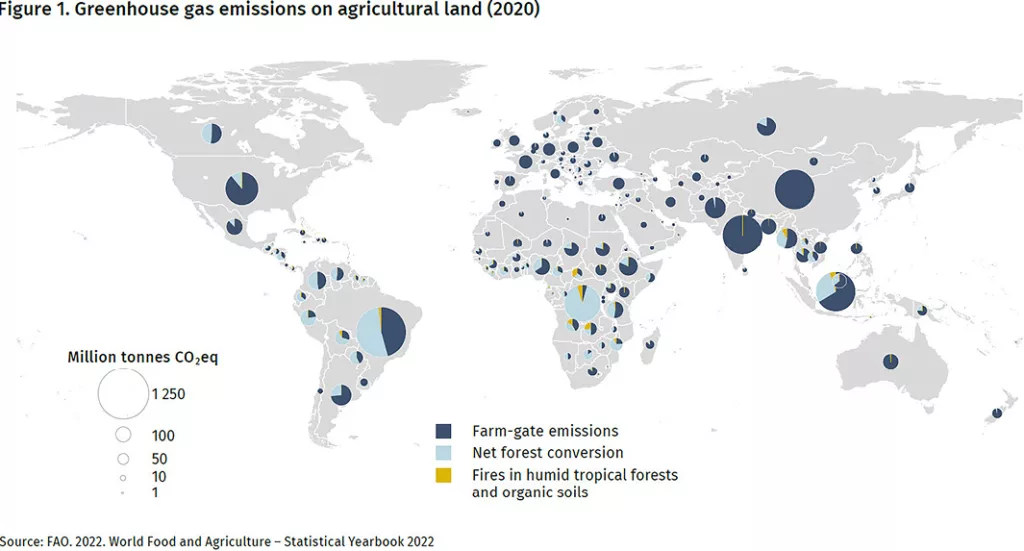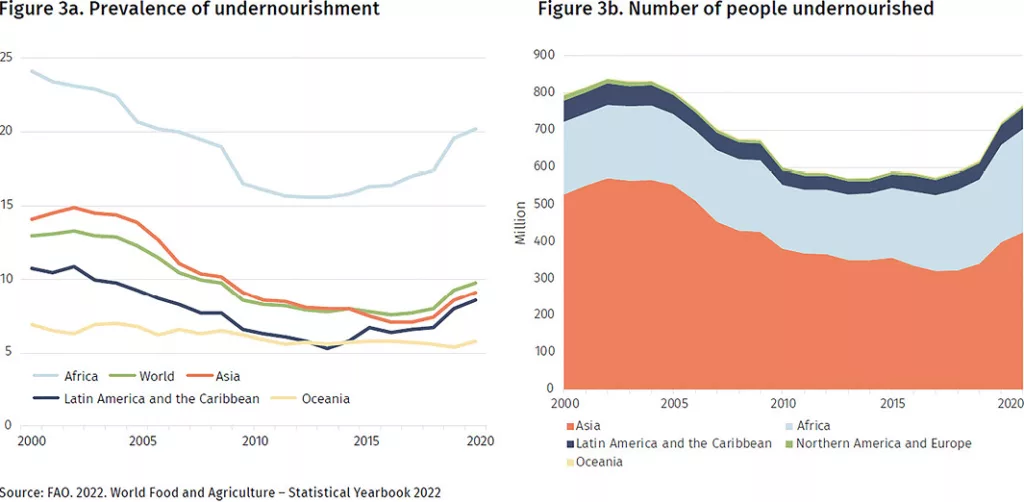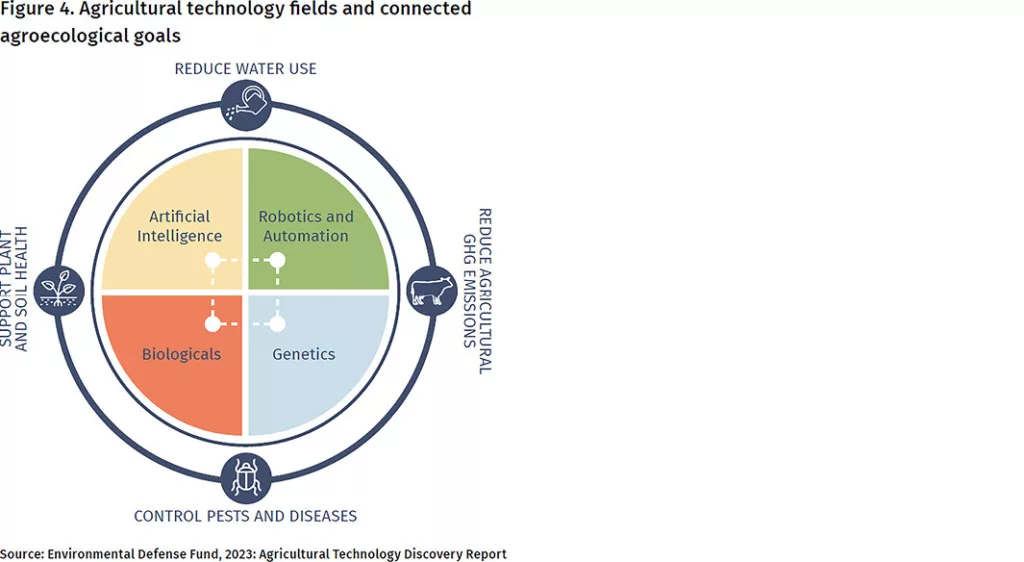Food production and consumption habits are already putting natural resources under pressure, and this challenging situation will be further intensified by the growth in the world’s population. Why our food system plays a central role in exacerbating climate change – and sustainable consumption beats the still urgently needed shift to regenerative food production in terms of sustainability.
Food systems comprise of all the stakeholders and activities involved in the production, aggregation, processing, distribution, consumption and disposal of food products. This complex network influences food security and has significant environmental implications. Food systems contribute extensively to greenhouse gas emissions, for example, thus intensifying climate change. As a result, climate change is expected to adversely affect the four core dimensions of food security: availability, accessibility, utilisation, and the stability of food supplies.
Our current food system feeds the vast majority of the world’s population and supports the livelihoods of over one billion people. This system stems from a century of innovation. Crop yields have risen to unprecedented levels, achieving greater efficiency on each plot of land and for every worker. As a result, the twentieth century saw food production surpass global population growth.
However, this progress comes at a cost. Our current food system is responsible for:
- 33% of anthropogenic greenhouse gas emissions
- 50% of methane emissions
- 60% of global biodiversity loss
- 75% of freshwater use
In short, food production is not only a major contributor to climate change but also harms the natural world’s ability to recover by degrading land productivity, water resources and soil health.

Climate change is, in turn, affecting food systems by triggering rising temperatures and extreme weather events. These changes have direct consequences on food production, including:
- A decline in the quality of biomass from rangelands and pastures
- An increase in the occurrence of crop and livestock pests and diseases
- Lower crop yields
- A reduction in the productivity of aquatic systems
- A decrease in the nutritional value of food
These developments create a pressing need to alter the way food is produced, processed and consumed – with implications for producers and consumers alike. Crucially, all these changes also threaten to reverse the progress achieved in reducing hunger and malnutrition around the globe.
The dual challenge of feeding the people of tomorrow
Based on the current food system, the UN Food and Agriculture Organization (FAO) estimates that it will be necessary to produce about 50% more food by 2050 in order to feed the expected global population of 10 billion. In fact, estimates suggest that between 691 and 783 million people in the world already faced hunger in 2022, 9% of the world’s population is undernourished, and 42% of the world’s population cannot afford a healthy diet. This situation will be further exacerbated by the impacts of climate change on access to − and the availability and utilisation of − food as well as the stability of diets of sufficient nutritional quality.

The ultimate objective of our food system should be to ensure that all people have access to healthy and nutritious food while minimising the harmful effects of food production and consumption on the environment and the climate. Today’s “net nature-negative” food system can and must become “nature-positive”. A nature-positive food system is characterised by a regenerative, non-depleting and non-destructive use of natural resources and is based on a regenerative system of agriculture. Regenerative agriculture is a holistic approach focused on achieving multiple goals at once: Increasing carbon capture, lowering greenhouse gas emissions, bolstering biodiversity, enhancing soil water retention, minimising pesticide use, optimising nutrient utilisation, and bolstering the livelihoods of farmers. A regenerative food system requires the transformation of the entire food value chain − from production and distribution to consumption.
Food production in a regenerative food system enhances land and water management, safeguards biodiversity, and restores soils and forests, all while helping to lower greenhouse gas emissions. Rather than “bending” nature in order to produce the food we need, food can be designed in a way that allows nature to thrive. This involves using:
- Diverse ingredients: To boost food supply resilience through greater genetic diversity, businesses can use diverse ingredients in their products. Instead of only using sugar cane or corn syrup for sweetness, they can opt for alternatives such as date palm, carob or natural sweeteners like monk fruit. Similarly, planting different crop varieties, like population wheat, enhances the resilience of global wheat production.
- Lower impact ingredients: Shifting from high-impact animal products to lower-impact alternatives, as well as from higher- to lower-impact crops, offers immediate benefits. Many companies are already transitioning from animal to plant proteins. Replacing wheat flour with pea flour in cereal can, for example, cut farm-level emissions by 40% and reduce biodiversity loss by 5%.
- Upcycled ingredients: A third of food is lost or wasted, but upcycling innovations can turn this food into valuable ingredients. The use of upcycled ingredients reduces land usage and enhances the efficiency of invested land, energy and other inputs used in food production.
- Regeneratively produced ingredients: Regenerative production can lead to higher yields and boost profitability for farmers. While there is no universal approach and practices may vary, certain practices boost food output and farmers’ profits, while also delivering climate and biodiversity gains. In addition, advancements in technology can boost the efficiency of food systems and thus support the transition to a regenerative food system. Specifically, technological developments such as Artificial Intelligence (AI), robotics and automation, biologicals, and genetics can contribute to four main agroecological goals:
- Reduce water use: With the aid of technologies like AI, soil moisture detectors and flow indicators, farmers can determine the best times and areas for watering their crops, leading to more efficient irrigation.
- Support plant and soil health: Advanced technologies can enhance soil and plant health through monitoring and by offering sustainable alternatives. Innovations in biological and genetics technologies support safer products for both humans and the environment. Furthermore, biologicals can cut fertiliser use and sequester carbon.
- Control pests and diseases: Technology can provide tools for effective pest identification, monitoring and control while bolstering plant resilience. These advancements streamline pest assessment, thus reducing labour requirements and improving response times. Moreover, genetic technologies can bolster plant resistance to biotic stress.
- Reduce agricultural greenhouse gas (GHG) emissions: The methods to cut agricultural GHG emissions vary, based on the emission source. For nitrous oxide, the emphasis is on soil management, primarily the reduction of fertiliser use. Methane reduction techniques target livestock processes, including halting emissions directly from the animal, and capturing and transforming emissions from manure.

Food loss and waste is defined as the decrease in the quantity or quality of food along the food supply chain. Food losses occur in the food supply chain from harvest through to retail, while food waste occurs in retail and consumption.
Combined food loss and waste amount to 25–30% of total food produced. In the period from 2010 to 2016, global food loss and waste equalled 8–10% of total GHG emissions. At a time when hundreds of millions of people worldwide are going hungry, it is striking that the amount of food lost and wasted per annum could feed one billion people.
Food waste, particularly within households, has reached a substantial level across different countries. When food waste occurs, this means that we see all of the environmental impacts of food production without the benefit of people being fed. Surprisingly, household food waste per capita is similar across high-income, upper middle-income and lower-middle income countries.
Minimising food waste and loss can help to reduce agricultural greenhouse gas emissions and eliminate the need to extend farmland to drive additional production. Implementing better harvesting methods, enhancing on-site storage, upgrading infrastructure and optimising packaging are effective ways to achieve this reduction.
Sustainable consumption beats new technologies
Consumers can make a difference by choosing products that are eco-friendly, socially responsible and nutritious. Diets with enhanced nutritional and environmental benefits can create environmental shifts beyond what producers can achieve solely through new technologies.
Avoiding food waste during consumption, reducing overconsumption, and changing dietary preferences can contribute significantly to ensuring healthy diets for all, as well as reducing the environmental footprint of the food system.
A comprehensive study found that consuming more animal-based foods generally results in a higher environmental footprint, while eating more plant-based foods tends to have a lower environmental impact. Meat from ruminants, especially beef and lamb, is consistently identified as the single food source with the most significant environmental impact, most often in relation to GHG emissions and land use.

Transforming dietary habits on a global scale is, however, a complex undertaking due to the interplay of various factors. Dietary choices often stem from deeply rooted cultural traditions or restricted access to a variety of foods.
In a world in which we are increasingly aware of how closely systems are interconnected, the intricate relationship between our food systems and climate change is particularly striking. Balancing the rising demands of a growing global population with the urgent need to drive environmental sustainability is a massive challenge. However, the tools for change − ranging from regenerative agricultural practices to sustainable consumption habits − provide tangible solutions. Adopting a holistic and regenerative approach to food production, distribution and consumption is today more vital than ever to achieve food security coupled with environmental sustainability.

